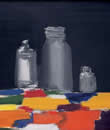Starting Out
Many painters cannot remember how they acquired their skills, which were seemingly absorbed through the skin, as one learns a foreign language in childhood. Coming to painting as an adult is a very different matter, however: the white canvas can seem intimidating, the paints quickly mix into an unexpected and often muddy hue, and still that elementary exercise on the third page of the painting guide seems beyond their powers. What can be done? A few suggestions:

1. Painting is taxing, mentally and physically. Techniques have to be learnt, requiring months or years of constant application to produce something of even modest competence. Don't despair, therefore, but do be realistic. Take it easy, proceed in stages, and set yourself targets for each stage.
2. Decide what you want to do, i.e. how much time, effort and money you can devote to the craft, setting or adjusting your sights accordingly. You'll get an idea of what's open to you within a few months of starting out, i.e. how well or otherwise you are covering the essential ground.
3. You must actually enjoy the exercise of painting. No doubt 'appetite grows with eating', but painting should be something you yearn to do every day of your life. If it's just the 'Wednesday class' at the local leisure center, then you'll get a lot of enjoyment out of working with like-minded people, but the results will probably be similar, neither particularly good nor bad.
4. You're very largely on your own. Classes, books and videos are a help — an enormous help — but painting in the end is a solitary activity, and not all aspirants have the personalities or determination needed for the long haul. You should know yourself by now.
5. We are all individuals, with different gifts and ambitions. Set yourself something that's within your capabilities, therefore, and don't worry overmuch when others seem to be streaking ahead. It's not a competition, and you will learn more from carefully working at failures than from dashing off paintings that came right first time.